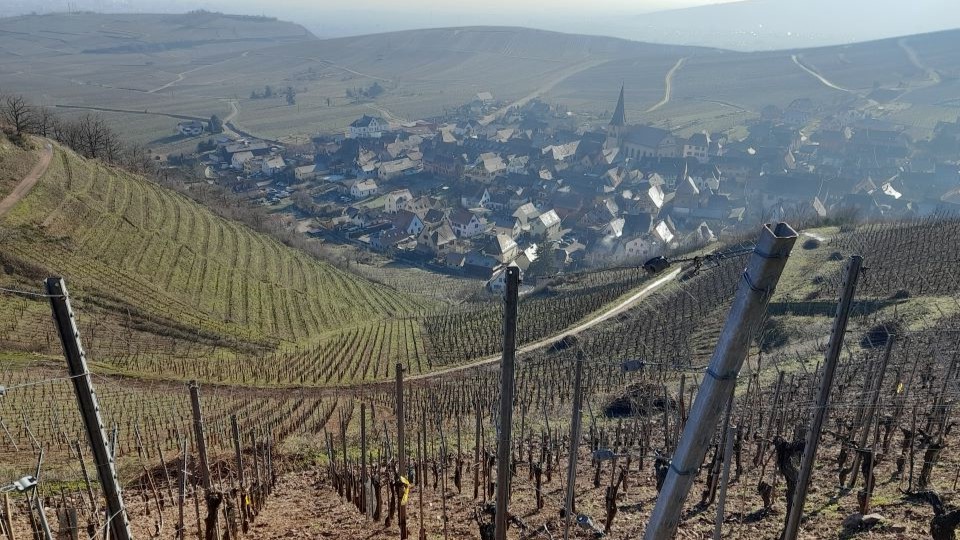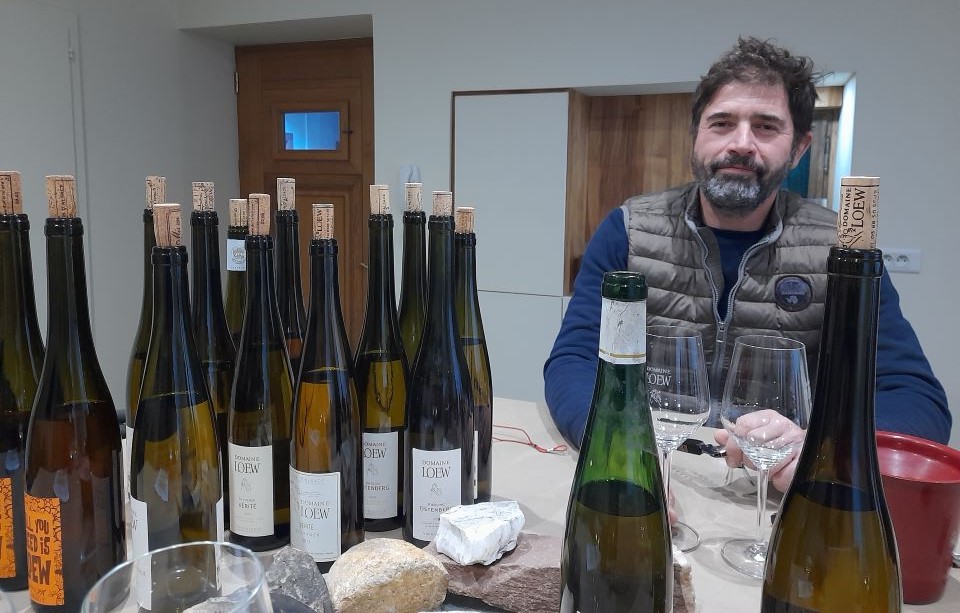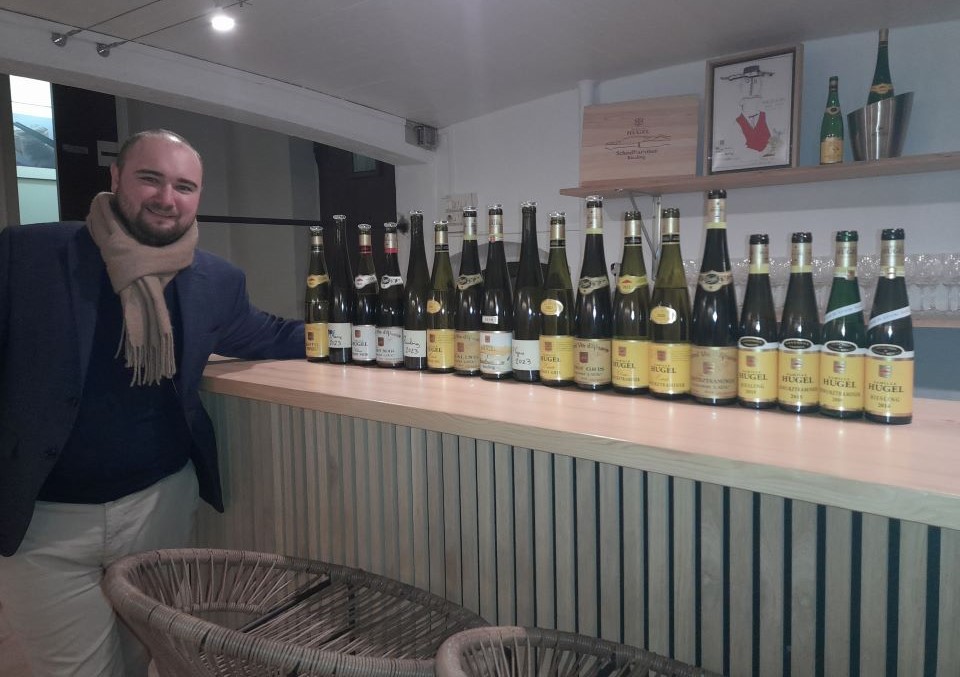Browse using the new Vinous website now. Launch →
Printed by, and for the sole use of . All rights reserved © 2015 Vinous Media
Alsace 2022 Whites – A Lucky Escape
BY ANNE KREBIEHL MW | APRIL 04, 2024
The first week of my Alsace trip in January 2024 was characterized by snow-covered conifers of the Vosges, negative temperatures and icy roads. While these conditions made driving tricky, ice and snow were a blessing both to vineyards and forests. They absorb meltwater and, along with already incessant rain in the fall and winter of 2023, they replenished their water reserves. But I will discuss that more next year. Most of the reviews in this report cover the 2022 vintage, along with a sizeable portion of 2021s as well as 2020s and 2019s – depending on the various release schedules of the growers. Although I tasted a mere handful of 2023s, the focus of this report remains on the 2022s.

The steep slopes of the Sommerberg Grand Cru look down on Niedermorschwihr.
Speaking with Hindsight
When speaking to growers, it became clear that the more recent experience of the 2023 harvest had already colored the view of the hot and dry 2022 vintage. Yes, dry stress occurred in 2022, but it paled in comparison to 2023. Like elsewhere, a warm and dry summer characterized the 2022 growing season in Alsace. While there was dry stress in some stony soils, especially in well-drained, steep, granitic and sandstone slopes, the limestone and marl soils fared much better. Thus, dryness rather than drought distinguishes the 2022 growing season. Compared to other regions in Europe, Alsace got away relatively lightly. Localized showers helped, even if an August hailstorm damaged the Brand and Sommerberg Grands Crus.
Growers were happy to have decent yields, albeit lower than the average, due to dryness after the often-devastating losses of 2021. This resulted in some stunning wines from concentrated grapes with expressive and juicy fruit flavors. Even the Sylvaners brim with fruit in 2022. The 2022 Rieslings show concentration and often come with a fine phenolic structure that makes up for the lower acidities when compared to 2021 – while tasting pristinely bright and fresh. I had already addressed this mechanism in my reports on Germany: less water moving through the vine in drier years means fewer minerals like potassium are deposited in the grapes. These minerals usually buffer the pH level of the resulting wines, but with lower deposits, there is less buffering and hence, even lower acidities shine brightly. Jean Boxler thinks that concentration rather than acidity determines the longevity of Riesling, as he grows Riesling on the steep and extremely well-drained granitic slopes of the Sommerberg Grand Cru. However, a variety like Riesling will always last the distance when planted in such a world-class site by such an assiduous grower. Vine age also made a crucial difference – younger vines suffered more than established, mature vines when it came to water stress. The white Pinots display fuller bodies and both Pinots and Gewurztraminers benefited from phenolic structure to balance the fruit – a practice that the wineries I visited are honing and fine-tuning with every year.

Even the bears like grapes in Alsace. This statue in Andlau combines the village's twin emblems: the bear and grapes.
2022 Growing Season – The Recap
"We were not hit by spring frosts," Olivier Humbrecht MW explained at Domaine Zind-Humbrecht. “Bud break was early to middling, and flowering began in Clos Jebsal on 20 May. The rest of the vineyards followed by the first week of June. Then temperatures got super hot later in June. Heat and dryness caused serious problems. While the hillside vines did better, due to later flowering, the Riesling on the valley floor suffered.”
The vines on the plain surrounding Turckheim and Colmar are on well-drained, gravelly and sandy soils without much clay and are thus prone to dry stress. Humbrecht notes: “As a result of the wet 2021, to begin with, the vines had huge potential yield-wise, but this was evened out by heat and drought between June and early August. We had a little rain in late June, which was beneficial. The year passed without major disease issues, except for the usual oïdium scare towards the end. The harvest started super early on the 22 of August, but then we stopped for a week. Most of the harvest took place in the first two weeks of September, with a few Gewurztaminer vineyards picked in late September. We had to be quick as ripeness was advancing fast because of some rain in mid-August. The Brand got a nice storm in August, which was super-beneficial.” He says this despite it turning into a hailstorm. “The storm moved on to Sommerberg, causing some grape loss and then moved further to Wineck-Schlossberg, where we lost half of our Riesling. Later, we wished for more hail as the vineyards spared from hail did not get water. This sounds crazy,” he laughs. “Apart from that, 2022 was a normal vintage with a huge difference between hillsides and valley floors in terms of yield,” he said. The vines on the plains saw a 50% reduction, while the ones on the slopes experienced only a 10-20% decrease, except for areas affected by hail.
In Alsace’s far north, Etienne Loew in Westhoffen said that “we had rain, always in extremis, so there was no stress.” Arnaud Baur of Domaine Charles Baur in Eguisheim sums it up: “Compared to 2021, 2022 brought much easier conditions, much drier, much sunnier, with balanced rain.” But not everyone was so lucky: Jean-Frédéric Hugel in Riquewihr observes that “most of France had a heatwave of 40-plus degrees Celsius. Alsace was spared the heat but not the drought. Two thousand twenty-two was our second-lowest harvest due to drought, as Riesling does not deal well with drought, while Gewurztraminer and Pinots love it.” Eddy Leiber-Faller said that on 15 August, 35mm of rain softly fell over the course of five to six hours, alleviating the Schlossberg Grand Cru. “This was providential,” he says, “after that, it was sunny but cooler.”
For the 2022 harvest, Humbrecht also notes that speed was key. “Sugar ripeness moves quickly, the physiological ripeness, too. For an average to smallish crop, we still had about 100 people in the vineyards. It was hot, so we wanted to finish early in the day. Humans and grapes suffer when temperatures rise above 30 degrees Celsius.” He also notes that most wines had very low malic acid levels, and while most wines go through malolactic conversion, “this did not really impact their balance.”

Etienne Loew in Westhoffen shows off both rocks and wines.
Cellar Challenges
Humbrecht says that despite low disease pressure making vineyard work easy, work in the cellar was hard. To him, this is not only due to lower mineralization via less sap flow in dry years (see above), when less nitrogen is deposited in the grapes, leading to less yeast-assimilable nitrogen, which is crucial in fermentation. He explains that “during drought and heat, soils enter dormancy. Microorganisms are sleeping, which is not a problem [since they easily revive with water], resulting in much less nitrogen production.” There simply is less nitrogen in the soil, not only less nitrogen deposited in the fruit. Humbrecht cites this as the chief reason for the sluggish ferments of 2022. At the Humbrecht cellar, where cultured yeasts are avoided, they inoculated slow ferments with livelier ones. His last 2022 wines finished fermenting in August 2023, and he notes that “often, the last half percent of alcohol is the most difficult to ferment.” His verdict is that “structure and acidity were possible to achieve in 2022, but it came with the sacrifice in yield.” Domaine Kreydenweiss, further north in Andlau, is another biodynamic estate that does not employ cultured yeasts. Maarten van Beurden notes that one of the takeaways from the 2022 vintage was the importance of intervening early with yeast from a lively ferment if fermentation slows down rather than leaving them to their own devices for too long. Because some ferments lasted into October 2023, Maxime Barmès of Domaine Barmès-Buecher in Wettolsheim had to bottle four times instead of the usual two or three.
2021: Work Like Never Before
Two thousand twenty-one stands in stark contrast to 2022. At Domaine Albert Mann, where the current release is 2021, Jacky Barthelmé describes the relentless nature of the 2021 growing season. He points out that the year was a lottery – some sites, especially around Eguisheim, were almost wiped out, and others got away with a minor loss of yield. “We had rain in spring,” he says, “which was good, but then it did not stop, not during flowering either. We have vineyards in 11 different communes and had mildew problems in two to three of them. We decided to stop working the soil, cut the grass in the vineyards to allow for more ventilation and we never hedged the tops of the vines so early – because this is where the mildew starts. While we tried to minimize spraying, some parcels required intervention twice or three times a week, and this is where we saved the harvest,” Barthelmé says about the month of May. “A big team de-leafed the canopy for ventilation and even spraying was done manually rather than by tractor. In this one month, we worked like never before. During flowering, we lost 5-10% of yield, resulting in millerandage, which, in the end, was a boon. [Due to looser grape bunches.] Then, we lost another 15-20% to mildew. Some parcels were not affected at all; in others, we lost 40%.” Barthelmé notes that Eguisheim, Katzenthal and Gueberschwihr were complicated, while the stony, steep sites of Schlossberg and Furstentum only saw 5% of losses. To make up for this, he remarks, “In the middle of August, the rain stopped. We had no rain during harvest,” adding that fermentations were easy.

Jean-Frédéric Hugel of Famille Hugel and his grandiose selection of wine.
Rules, Rules, Rules
Since 2011, Alsace allows labeling wines with communal or Village appellations so long as they conform to more restrictive production guidelines. Right now, there are 14 of these. Some villages limit certain varieties to specific outlined vineyards, like Gewurztraminer in Bergheim, for instance. “A silly appellation” is Sylvie Spielmann’s succinct verdict. Hence, Mathieu Deiss labels his village wine Berckem rather than Bergheim, and Kreydenweiss now labels their village Riesling, which used to be called Andlau, ‘Riesling Au Dessus de la Loi’, or Riesling above the law, due to these regulations. Some wine growers wonder if these village appellations serve a purpose or are just another layer of nonsense.
Residual sugar in Riesling remains a controversy. After authorities ruled in 2021 that all Riesling except for Vendange Tardive and SGN must be legally dry to be labeled varietally, Rolly Gassmann started a movement against the ruling. His petition has gained more than 5,000 signatures from around the world so far. “The most important thing is whether the wine is good or not. The rest does not matter,” he says. “We cannot throw 2,000 years of history on the rubbish heap.” To him, this is “a new war.” I fear these discussions will rage on – when the real problem is structural, not legal.
Ongoing Consolidation
In last year’s report, I noted that “according to figures by CIVA, of the roughly 4,000 Alsace grape growers, 48% are cooperative members and 35% sell wine in bulk, which leaves independent wineries at just 17%.” This year, several growers spoke with concern about the impending merger of two already large cooperatives: that of Wolfberger, based in Eguisheim, comprising between 300-400 grower members and covering roughly 1,200 hectares of vineyards, and Bestheim, based in Bennwihr, representing as many growers, with around 1,400 hectares of vineyard. Bestheim itself is the result of “successive mergers,” as they put it, between the smaller co-operatives of the villages of Bennwihr, Westhalten, Obernai, Sigolsheim and Kientzheim-Kaysersberg. This merger is likely to create a juggernaut that, in one fell swoop, would control 2,600 hectares of vines – representing 17% of Alsace’s total 15,471 hectares of vineyards, selling under the Bestheim and Wolfberger brands, plus the Lucien Albrecht and Willm brands, both owned by Wolfberger. This follows the distribution deal signed in 2022 between Arthur Metz, a huge player in the Crémant business owned by Grands Chais de France, and the roughly 300-hectare cooperative Cave des Vignerons de Pfaffenheim. Grands Chais de France, a wine producer and négociant with a strong French and pan-European winery portfolio, complete with a global logistics network, is owned by the Alsace-based Helfrich family, who also now bring Dopff & Irion, part of Pfaffenheim, under their distribution. This is quite some consolidation in this relatively small region.

Laure Adam and her father, Jean-Baptiste Adam, with one of their old ledgers.
Behemoth Bubbles
Séverine Schlumberger of Domaines Schlumberger in Guebwiller says that once the respective co-operatives’ members vote in 2025, Wolfberger and Bestheim will come together and become a monster, make the weather, and set the tone. In her view, these businesses “have backed a horse that cannot run. They were enemies yesterday, and today, they are friends not by choice but by necessity. And it makes it harder for those of us who want to make quality wines.” The business model relies on quantity, high yields and competitive pricing – a race to the bottom. Marc Tempé of Domaine Marc Tempé says that these behemoths “in the past at least had different voices, now they are one giant voice, almost a monopole that can depress prices. To make everything tally, they have to push up yields.” At least half of Bestheim’s output is Crémant – or six million bottles. CIVA, the Comité Interprofessionnel des Vins d'Alsace, states in its latest production figures that “AOC Crémant d’Alsace rose to 33%, a third of the bottles produced, a new record.” This means in 2023, one-third of all Alsace grapes were made into Crémant. In 2022, it was 28%. This stands vis-à-vis a production of just 3% of Grand Cru wines, down from 4% the previous year. “With more than 43.2 million bottles produced,” CIVA continues. “Crémant d’Alsace exceeded its previous record established in 2018 with 41.3 million bottles.” This goes hand in hand with the fact that Pinot Blanc (a statistic that subsumes Auxerrois plantings) now is the most planted variety in Alsace, with 24.6% to 72% of it used for sparkling production of perfectly competent, clean but mass-produced wines that can sell for less than five Euros in French supermarkets but usually retail around the seven to nine Euro mark.
The gap between quality and quantity is thus getting steadily bigger. Another grower tells me that some of the Scandinavian liquor monopolies send out tenders based on “crazy prizes” that artisanal winemakers simply cannot achieve. The big question is what these oceans of Alsace wine do for the prestige of the region. When I look at this with optimism, it may well present a great opportunity for those who uphold artisan production with a focus on site, soil and environment. This report contains notes on some delicious Crémants that are the antithesis of anodyne fizz.
I tasted the wines in this report during estate visits in January 2024.
© 2024, Vinous. No portion of this article may be copied, shared or re-distributed without prior consent from Vinous. Doing so is not only a violation of our copyright, but also threatens the survival of independent wine criticism.
You Might Also Enjoy
Evoe! German and Austrian Sekt Report, Anne Krebiehl MW, March 2024
2022 Burgenland and Austria’s East – A Heaven for Unsung but Compelling Reds, Anne Krebiehl MW, February 2024
Alsace 2020s and 2021s: Just like Janus, Anne Krebiehl MW, April 2023
Show all the wines (sorted by score)
- Agathe Bursin
- Albert Boxler
- Albert Mann
- Barmès-Buecher
- Beck-Hartweg
- Dirler-Cadé
- Domaine Amélie & Charles Sparr
- Domaine Bott-Geyl
- Domaine Bruno Sorg
- Domaine Charles Baur
- Domaine Emile Beyer
- Domaine Kirrenbourg
- Domaine Léon Beyer
- Domaine Mélanie Pfister
- Domaine Rémy Gresser
- Domaines Schlumberger
- Domaine Trapet
- Domaine Valentin Zusslin
- Domaine Weinbach
- Emile Boeckel
- Etienne Loew
- Famille Hugel
- Henry Fuchs
- Jean-Baptiste Adam
- Jean- Claude Buecher
- Josmeyer
- Julien Schaal
- Kuentz-Bas
- Léon Boesch
- Marcel Deiss
- Marc Kreydenweiss
- Marc Tempé
- Ostertag
- Rolly Gassmann
- Schoffit
- Sophie Schaal
- Sylvie Spielmann
- Trimbach
- Véronique & Thomas Muré - Clos Saint Landelin
- Zind Humbrecht
